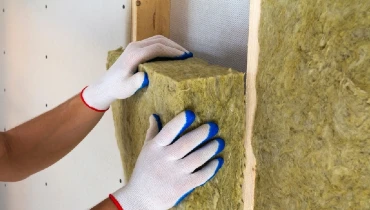Should You Insulate Interior Walls?

The insulation in the exterior walls of your home keeps you warm in the winter and cool in the summer. But since they don't protect your home from the elements, should you insulate interior walls? In some cases, yes, interior walls benefit from insulation. The expert service professionals at Mr. Handyman® have put together a comprehensive guide on the advantages of insulating interior walls and when not to, what type is best for your scenario, and how to mitigate interior wall insulation issues.
Advantages of Insulating Interior Walls
Insulating interior walls offers several benefits beyond just temperature control. Whether for comfort, energy efficiency, noise reduction, or fire safety, interior wall insulation can enhance a home in multiple ways.
Sound Protection
Beyond serving as a barrier between indoor and outdoor temperatures, insulation can also act as a sound barrier. For walls that separate apartments or condos, and shared walls in multi-generational homes, insulation will help keep sound from traveling through the walls, keeping conversations and activities private by reducing sound transmission. Insulated interior walls are also helpful for bedrooms that require peace and quiet, like a nursery, bedroom, and home office as well as reduce the sound transfer from plumbing pipes, laundry rooms, or mechanical equipment.
Fire Protection
Install an extra layer of fire protection with fire-retardant insulation. Some insulation materials, like mineral wool or fiberglass, can act as a fire barrier and slow the spread of flames, adding extra safety in multi-story homes or shared living spaces.
Additionally, some local building codes require the use of fire-resistant drywall between a garage and a living space. Combined, fire-resistant drywall and fire-retardant insulation will increase the wall's fire rating to a minimum of 1 hour, from the 30-minute rating for standard 1/2-inch drywall.
Energy Efficiency
Much like adding properly rated insulation to your exterior walls, adding insulation to your interior walls will help regulate indoor temperatures throughout your home. Keeping temperature fluctuations at bay in rooms that aren’t used frequently, like guest rooms and storage rooms, reduces the strain on heating and cooling systems and makes your home more cost-effective in the long run.
Interior Wall Insulation: Potential Issues & Mitigation
As you consider whether you should insulate interior walls, you need to be aware of some challenges. Here's what to watch out for—and how to prevent common pitfalls.
Thermal Bridging
Thermal bridging happens when heat moves through solid materials—like wall studs—bypassing insulation. This can lead to cold spots and reduce the effectiveness of your insulation. To counteract this, consider:
- Continuous Insulation: Installing rigid foam or spray foam insulation across wall surfaces to break thermal bridges.
- Double Stud Walls: Using staggered or double-stud framing can reduce direct heat transfer.
Moisture Buildup and Mold Growth
Insulation can trap moisture inside walls if not properly managed, creating the perfect environment for mold. To prevent this:
- Install Vapor Barriers: Include a vapor barrier on the warm side of your wall to reduce condensation, especially in humid climates.
- Ensure Proper Ventilation: Rooms like bathrooms and kitchens require adequate airflow to prevent excess humidity.
- Opt for Moisture-Resistant Insulation: Closed-cell spray foam or rigid foam panels resist water absorption better than fiberglass batts.
What Kind of Insulation Is Needed for Interior Walls?
For sound-deadening properties, you can use many types of insulation, such as fiberglass batt insulation, cellulose, spray foam, or rock wool and each has its own best applications.
Fiberglass Batt Insulation
Most commonly used between bedrooms, living areas, and shared walls, fiberglass batt insulation comes in pre-cut batts that fit between wall studs and is the go-to for situations where your walls are open and the studs are exposed. It provides moderate thermal insulation and sound protection. And while it is fire- and moisture-resistant, it can absorb water if exposed.
Blown-In Cellulose Insulation
Blow-in cellulose insulation works well for adding insulation to existing walls without removing drywall. Made from recycled paper and treated with fire retardants, it provides good sound protection and energy efficiency when retrofitting projects. Note that it can settle over time, especially if not properly installed, reducing its effectiveness.
Spray Foam Insulation
Known for maximum energy efficiency, air sealing, and moisture control, spray foam insulation comes in open-cell (better for sound protection) and closed-cell (better for moisture control) varieties and expands to fill small gaps and cracks to prevent air leaks. Contractors love using spray foam insulation in humid areas, including bathrooms, and basements due to its moisture resistance and excellent long-term performance.
Mineral Wool (Rock Wool) Insulation
Rock wool insulation is the go-to for fire resistance, and sound protection, and is known for its long durability. Highly fire-resistant, rock wool can withstand temperatures up to 1,800°F, provides better sound protection than fiberglass, and because it doesn’t absorb moisture, it reduces the risk of mold. Rock wool is the ideal insulation for multi-family units, between floors, and shared walls in noisy areas.
Rigid Foam Board Insulation
Thin walls and moisture-prone areas like basements and bathrooms benefit from rigid foam board insulation. Made from polystyrene, polyisocyanurate, or polyurethane rigid foam board insulation provides high insulation value with minimal thickness. In addition to offering moisture resistance while allowing you to maximize space, it can be used behind drywall or remain exposed if covered with a fire-resistant layer.
Related Topic: The Benefits of Window Insulation Kits
Hire An Insulation Expert
So, should you insulate interior walls? For reduced noise from room to room, lower energy bills, and improved fire protection, yes, insulating the right interior walls can make a big difference. Your local Mr. Handyman can help you find the best insulation and identify interior walls that will benefit the most from insulation. We are experts at helping homeowners complete all types of home projects, both big and small. What’s more, we’re backed by the Neighborly Done Right Promise® to ensure your satisfaction. Give us a call or request an estimate today.
This article is intended for general informational purposes only and may not be applicable to every situation. You are responsible for determining the proper course of action for your home and property. Mr. Handyman is not responsible for any damages that occur as a result of this blog content or your actions. For the most accurate guidance, contact your local Mr. Handyman location for a comprehensive, on-site assessment.
 Click to call
Click to call


